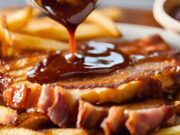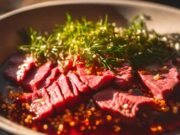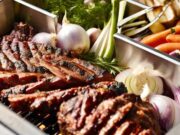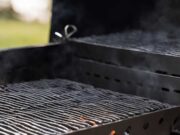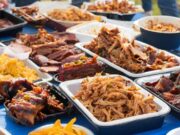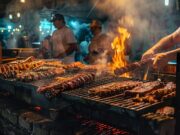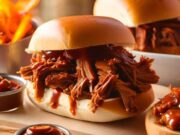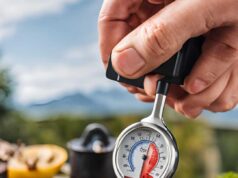Low and slow BBQ cooking is an art form that transforms simple ingredients into exquisite culinary creations. If you have ever desired that tender, smoky flavor resulting from hours of meticulous preparation, this guide is tailored for you.
You will discover essential tips and techniques that will enhance your BBQ skills, guaranteeing juicy meats and rich flavors that will impress your friends and family. Prepare to unlock the secrets to perfecting your BBQ expertise.
Key Takeaways:
- Master the art of low and slow cooking to create tender, flavorful BBQ dishes.
- Invest in quality equipment like a smoker or charcoal grill to achieve the perfect low and slow cook.
- Learn different techniques like using a dry rub, wrapping in foil, and mopping to elevate your BBQ game.
Understanding Brisket: A Comprehensive Guide
Brisket, a cut of beef sourced from the lower chest or breast area of cattle, is a favorite among BBQ enthusiasts and is often associated with renowned pitmasters like Aaron Franklin, recognized for his expertise in preparing this exquisite meat.
The rich flavor and tenderness of brisket arise from its unique composition of fat and connective tissue, which, when cooked properly, delivers a melt-in-your-mouth experience enhanced by the rendering of gelatinous tissues.
Whether you choose to smoke it on a Weber Smokey Mountain, grill it on a Kamado Joe, or cook it on a Traeger, brisket has solidified its place as a staple in American barbecue culture, especially when sourced from either corn-fed or grass-fed cattle.
Types of Brisket Cuts
Regarding brisket, understanding the different types of cuts is essential for anyone aiming to create an unforgettable BBQ experience.
The two primary cuts are the flat and the point, each offering distinct flavors and textures that cater to various culinary preferences.

1. The Flat Cut
The flat cut of brisket is well-known for its lean texture and is often the preferred choice for individuals seeking a healthier option without compromising on flavor. It typically requires specific cooking temperatures to ensure optimal tenderness and can be prepared successfully in both the oven and on the grill.
To achieve the best results, it is recommended to cook the brisket at a low temperature of around 225°F to 250°F for several hours. This method allows the meat to break down and become tender while developing a delicious crust. Using a dry rub or marinade with ingredients such as garlic, paprika, and black pepper can further enhance the brisket’s rich flavor.
For traditional BBQ enthusiasts, the flat cut is especially valued for its ability to absorb smoke, making it an excellent match for various wood chips like hickory or mesquite. While the point cut offers more marbling and a richer flavor, the flat cut is ideal for those seeking a lighter yet still satisfying BBQ experience.
2. The Point Cut
The point cut of brisket, known for its marbling and higher fat content, is renowned for its rich flavor and is particularly favored for creating delicious burnt ends, which showcase its unique gelatinous and connective tissue properties.
To fully appreciate this cut, you may want to employ methods such as smoking or slow cooking, which allow the fat to render effectively, keeping the meat succulent and tender. Traditional BBQ recipes often include a flavorful rub or marinade that enhances the already robust taste. By smoking the point cut for several hours, you can achieve that sought-after melt-in-your-mouth texture.
Alternatively, slow cooking it in a BBQ sauce can result in a delightfully sticky glaze. Once cooked, you can easily transform the point cut into burnt ends by cutting it into cubes and returning them to the grill or smoker with additional sauce, yielding an irresistible bite that’s perfect for gatherings.
Cooking Methods for Brisket
There are various methods for cooking brisket, each offering distinct results in flavor and tenderness.
Popular techniques include traditional BBQ smoking, sous vide cooking, and grilling. Mastering these methods necessitates a thorough understanding of the appropriate cooking temperatures to achieve optimal outcomes.
1. Smoking Brisket
Smoking brisket is widely regarded as one of the most esteemed methods among BBQ enthusiasts. The low and slow cooking process on a BBQ smoker, such as the Weber Smokey Mountain, Kamado Joe, or Traeger, infuses the meat with deep, rich flavors while maintaining its tenderness and juiciness.
Selecting the appropriate type of wood can significantly enhance your smoking experience. Hickory and mesquite deliver robust flavors, while fruit woods like apple and cherry provide a milder, sweeter essence.
Ideally, smoking should occur at temperatures ranging from 225 to 250 degrees Fahrenheit. This temperature range allows for several hours of cooking, typically requiring 1 to 1.5 hours per pound of brisket.
To maintain that signature smoke flavor, it is essential to infuse wood chips or chunks throughout the smoking process.
For achieving the perfect bark, employing a good rub, ensuring consistent temperature, and exercising patience during the cooking process are crucial. This approach will guarantee that the finished product is not only flavorful but also visually appealing.
2. Sous Vide Brisket
Sous vide cooking offers precise temperature control, making it an exceptional method for preparing brisket. This technique allows the connective tissue to break down slowly, resulting in a tender cut enriched with gelatin that retains its moisture.
For optimal results, you should cook brisket in a sous vide bath at temperatures ranging from 155°F to 175°F for 24 to 48 hours. The extended cooking times facilitate the breakdown of tough fibers, producing a melt-in-your-mouth texture that is difficult to achieve with traditional cooking methods.
The sous vide process ensures that the brisket cooks evenly, eliminating the risk of overcooking certain areas of the meat. After the sous vide bath, it is advisable to finish the brisket by searing it on a hot grill or skillet, which develops a rich crust and enhances both flavor and presentation. This final step truly elevates the overall dining experience.
3. Grilling Brisket
Grilling brisket can be a quick and flavorful option, but it requires careful monitoring of cooking temperatures to prevent drying out. This technique allows for the development of a delicious crust and can be employed to create mouthwatering burnt ends.
To achieve the best results, it is essential to aim for an internal temperature of around 195 to 205 degrees Fahrenheit. This temperature range ensures that the meat becomes tender and easily shredded. Utilizing a two-zone grilling approach not only helps maintain consistent heat but also facilitates the formation of that coveted crust.
The ideal preparation may involve applying a generous rub of spices, allowing the flavors to permeate the meat. Regarding leftovers, transforming any remaining brisket into burnt ends is straightforward: simply cube the meat, apply additional seasoning, and give it a second round on the grill to achieve perfect caramelization.
Frequently Asked Questions
What is low and slow BBQ cooking?
Low and slow BBQ cooking is a cooking technique that involves using low heat and longer cooking times to slowly cook meats, resulting in tender and flavorful dishes.
What are the benefits of low and slow BBQ cooking?
The main benefit of low and slow BBQ cooking is that it results in tender and juicy meats with a rich smoky flavor. It also allows for more control over the cooking process and can be done using a variety of equipment such as a smoker, charcoal grill, or even a slow cooker.
What are some tips for low and slow BBQ cooking?
First, make sure to use a good quality meat and season it well. Next, use a thermometer to monitor the temperature and avoid opening the lid too often to maintain a consistent heat. Also, consider marinating or using a rub to enhance the flavor. Lastly, be patient and resist the urge to turn up the heat, as low and slow cooking takes time but results in delicious dishes.
What are some common mistakes to avoid in low and slow BBQ cooking?
One common mistake is using too much wood or charcoal, resulting in bitter or overly smoky meats. Another mistake is not allowing enough time for the meat to cook, leading to tough and dry dishes. It’s also important to properly manage the vents to control the airflow and temperature, as too much or too little can affect the cooking process.
What types of meats are best for low and slow BBQ cooking?
Tougher cuts of meat with a lot of connective tissue, such as brisket, pork shoulder, and ribs, are best for low and slow cooking. These meats benefit from the longer cooking times, which allows the connective tissue to break down and result in tender and flavorful dishes.
Can low and slow BBQ cooking be done on a gas grill?
Yes, low and slow BBQ cooking can be done on a gas grill by using indirect heat. This means turning off the burners on one side of the grill and placing the meat on the other side, allowing for a lower and more consistent temperature. However, using a smoker or charcoal grill may result in a more authentic and smokier flavor.








